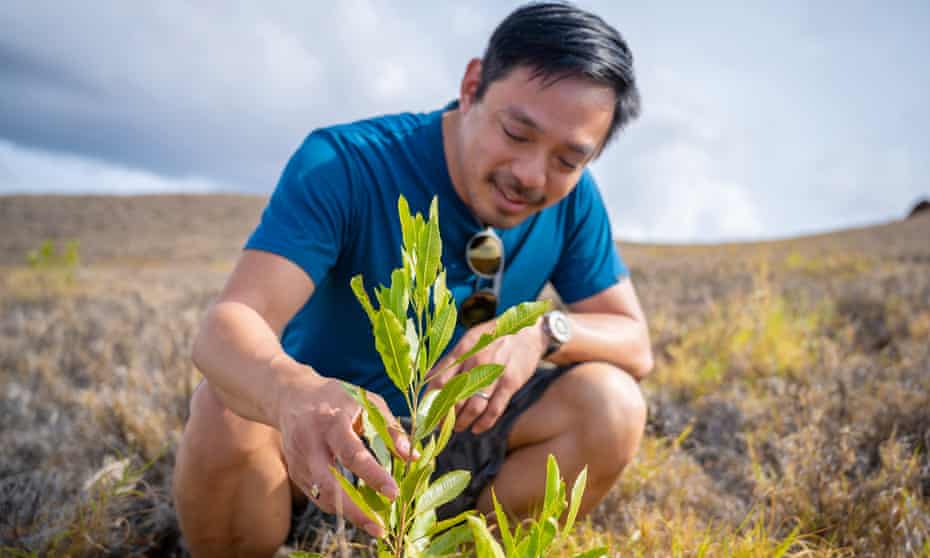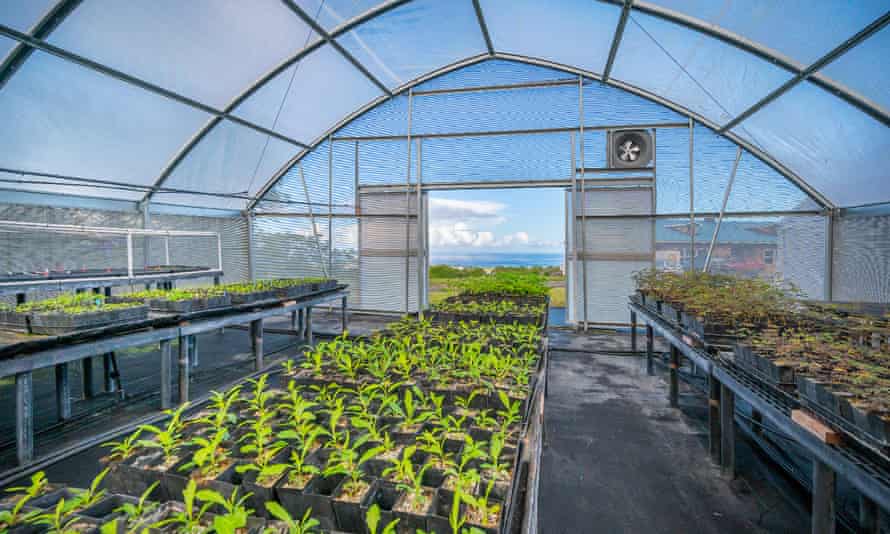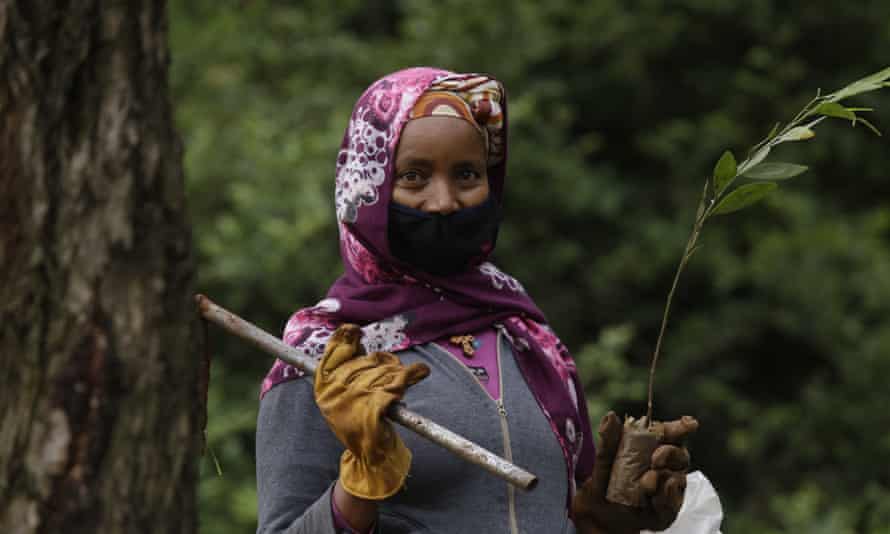Could planting a trillion trees stop global heating? This man thinks so

Former Reddit CEO Yishan Wong has founded a company, Terraformation, aiming to reforest 3bn acres but others doubt that trees are a magic bullet for the climate crisis
Last modified on Thu 28 Oct 2021 11.13 EDT
In 2017, Yishan Wong was ready to retire in Hawaii after leaving behind his career in Silicon Valley. The CEO of Reddit until 2014, Wong had previously held senior positions at Facebook and PayPal. But then came what he calls the “moment” when he decided he was going to take on the climate crisis instead.
“I was literally on a beach trying to retire, and it was too hot,” he said. Temperatures in Hawaii at the time were abnormally high, and he thought: “The planet has a climate change problem. I need to solve it.”
Wong started looking for “the most cost-effective per unit way” of removing CO2 from the atmosphere. After digging into climate science papers, he settled on his solution: trees.
In 2019, he founded Terraformation, with the aim to help reforest 3bn acres of degraded land around the world – an area bigger than the US – which Wong estimates could hold a trillion trees. He believes these forests could absorb enough CO2 to halt global heating.
Reaching net zero by 2050 means drastically reducing emissions, but to achieve this goal within such a short timeframe, and keep global heating within 1.5C, means also figuring out how to remove carbon from the atmosphere. An estimate by the Intergovernmental Panel on Climate Change envisions the removal of 730bn metric tons of CO2 this century.
Carbon-removal technology – sucking carbon from the air and then storing or using it – is one way to do this but is expensive and will take time to scale up. The International Energy Agency estimates that these technologies absorb about 40m metric tons of carbon a year. Trees, on the other hand, collectively absorb about 7.6bn metric tons a year – more than the annual emissions of the US – even after accounting for the emissions released by deforestation, wildfires and other causes.
“We’ve already done the R&D,” said Wong. “A trillion trees has a very, very strong possibility of solving the [climate] problem,” he said, when paired with cuts in carbon emissions. Reforestation is “immediately scalable”, he said, adding that the world cannot afford to wait until carbon capture technologies are ready for large-scale deployment: “You’re accumulating debt, the planet is warming in the meantime.”
Reforestation is also a more inclusive solution to the climate crisis, Wong said, because it is accessible to developed and developing countries alike. Solving the climate crisis will be “a real stretch of the human race’s collective abilities”, he said, so “you want the simplest, most affordable solution because it will operate at enormous scale.”
Terraformation won’t plant a trillion trees itself. Instead, it describes its product as “reforestation in a box”. Its clients are landowners, conservationists and governments who want to reforest areas around the world. Terraformation’s aim is to eliminate the “bottlenecks” to these projects.
The company applies a “holistic” approach, said Jill Wagner, its chief forestry officer. Depending on a project’s needs, Terraformation can provide seed banks and nursery kits in shipping containers; it can also offer financing, software and training. The company will also work with clients to sell carbon credits once their trees are planted.
Seed shortages are one of the biggest obstacles to reforestation, said Wagner. “Most people, even in the forestry field, don’t bank seeds,” she said. “They just collect seeds and propagate what they have for the year. That’s really limiting and that’s not a way you can scale.” Terraformation has produced off-grid, modular seed banks that can hold up to 5m seeds, which the company says is enough to reforest 5,000 acres.

Terraformation began in 2019 by reforesting a 45-acre tract of Wong’s own property in the North Kohala area of Hawaii’s Big Island. Once a thriving sandalwood forest, it had been destroyed after years of logging and grazing, said Wagner. The company established 6,000 native plants on this property, watered by a solar-powered desalination system. Many of the trees are already over six-feet tall, Wagner said.
The company has raised $30m from Silicon Valley investors and more than $2m so far on the crowdfunding site Republic. It now has 30 projects that are active or in the pipeline. Several projects are in Hawaii but it is also working with partners around the world, including in Uganda, Tanzania, Ukraine, India, Haiti and Ecuador.
Terraformation has “the technology to really reproduce native trees in a systematic way”, said Maria Jose Iturralde, the CEO of Humans for Abundance, a non-profit that is partnering with the company to reforest 200 hectares (494 acres) in the Amazon rainforest.
Iturralde said that Terraformation had provided “state of the art” nurseries and seed banks, which are helping indigenous families to restore these lands to the native ecosystems of their ancestors. The seed banks will be particularly useful to reforest the guayacan tree, she said, which produces seeds only once every two years.

The idea of global reforestation as a climate solution has been around for decades. But it has rocketed up the agenda. Along with Terraformation, trillion-tree-growing campaigns have been started by the World Economic Forum and prominent environmental groups, and tree planting has been embraced by high-profile figures from Jane Goodall to Donald Trump.
However, some scientists have said that tree planting has limitations as a climate solution, not least because the world may not have enough land to support a trillion new trees without harming the environment or people. A study published in 2019 claiming that tree planting was “the most effective solution to climate change to date” generated controversy, with several scientists criticizing its conclusions as overstated. In 2020, the authors issued corrections acknowledging the uncertainty of how much carbon trees could absorb and downgrading their analysis of tree planting as the most effective climate tool to “among the most effective”.
“There is a small but important role that forests can play in mitigating climate change,” said Joseph Veldman, a professor at Texas A&M University and a leading critic of the paper. But, he added, “can they do so at a scale that can tackle climate change? The answer is clearly, if that’s our only action, no.”
The main limiting factor for reforestation is the availability of land that can support new trees. A recent study found 678m hectares (nearly 1.7bn acres) around the world that could be reforested, short of Terraformation’s goal of 3bn acres. The study excludes grasslands, croplands and population centers, which are not suitable for reforestation. “You don’t want to put trees where they did not occur originally. That’s bad for biodiversity, and often the trees don’t survive,” said Susan Cook-Patton, a forest restoration scientist at the Nature Conservancy and co-author of the study.
It’s also important not to establish new forests in areas that reflect sunlight and cool the planet, said Sassan Saatchi, a senior scientist at Nasa’s Jet Propulsion Laboratory. Planting trees in areas such as boreal regions of Canada and Russia or certain deserts could actually cause a rise in global temperature. “One type of solution is not going to fit all,” said Saatchi. “We need to do the calculation for each region differently.”
There’s also a potential disruption to people when deciding where to place trees. “What I’m concerned about,” said Karen Holl, a professor of environmental studies at the University of California Santa Cruz, is tree-planting initiatives that “look at it as a math problem and don’t think about the ecology and the people involved”. She added that “it’s not just a matter of putting trees in the ground.” She highlighted the need to meaningfully engage with local communities – especially indigenous peoples – whose livelihoods might be affected by reforestation.

It’s not possible to predict the “side-effects of massive global reforestation”, said Wong, because “that’s how big projects work”. But he said Terraformation will “listen to and co-author with the local community” and will focus on restoring native ecosystems rather than planting monoculture species, which can harm the environment. “If you restore native species where they were, they grow back way faster than you expect,” he said.
Wong said he viewed the problem of climate change with an engineering mindset. “You need to shoot for the lowest-risk thing that will get you into the right order of magnitude,” he said. “Usually, if you get to a tenth [of the way to the solution], you’re in the order of magnitude. You can do 10 times of whatever you’re doing now.”
Although Wong recognizes the complexities of tree-planting, he also believes that forests can be a big financial opportunity, for example, from carbon credits and agroforestry. “It’s a valuable thing when you convert degraded land into a thriving ecosystem,” he said.
“Tackling climate change is like building a house; reforestation is like a hammer,” said Cook-Patton. “Is it the sole tool that you can use to build the house? Absolutely not. But is it a valuable tool? Yes.”
